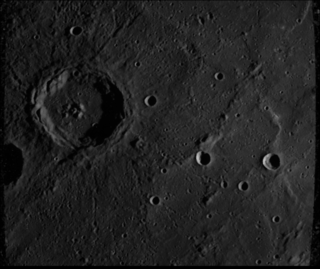
Planetary nomenclature, like terrestrial nomenclature, is a system of uniquely identifying features on the surface of a planet or natural satellite so that the features can be easily located, described, and discussed. Since the invention of the telescope, astronomers have given names to the surface features they have discerned, especially on the Moon and Mars. To standardize planetary nomenclature, the International Astronomical Union (IAU) was assigned in 1919 the task of selecting official names for features on Solar System bodies.

Canso is a Martian crater. It lies about 450 kilometres west of the Viking 1 lander, slightly northeast of Lunae Planum, and west of Chryse Planitia, in the Lunae Palus quadrangle. The crater is named after Canso, a fishing town in Nova Scotia. The name was officially adopted in 1988 by the International Astronomical Union's Working Group for Planetary System Nomenclature (IAU/WGPSN).

Davies is a crater on Mars located at 46°N 0°E on the fringe of Acidalia Planitia near Arabia Terra. It is approximately 48 km in diameter. The crater's name was formally approved by the IAU in 2006.

Dollond is a small lunar impact crater that is located in the central region of the Moon, to the north of the crater Abulfeda. It was named after British optician John Dollond. Due west of Dollond is Anděl. Dollond is circular and cone shaped, with a tiny floor at the midpoint of the sloping interior walls.

Zola is a crater on Mercury. The crater was named after the French novelist and playwright Émile Zola by the IAU in 1979.

Homer is a crater on Mercury. It is one of many Peak-ring basins on Mercury.

Darwin is an impact crater on Mars, located at 57°S 19°E to the southeast of Argyre Planitia in Noachis Terra. It is approximately 176 km in diameter. The crater's name was formally approved by the IAU in 1973.

Roddenberry is a crater on Mars, located at 49°S 4°W to the east of Argyre Planitia in Noachis Terra. It measures approximately 139 kilometers in diameter. The crater is named after Gene Roddenberry, creator of the television series Star Trek, and was formally approved by the IAU in 1994.

Arrhenius is an impact crater in the Eridania quadrangle on Mars at 40.3° S and 237.4° W. and is 129.0 km (80.2 mi) in diameter. Its name, for Svante Arrhenius, was approved in 1973 by the IAU. Evidence of previous glacial activity is evident in images. There also appear to be branched channels just outside the crater.

Vogel is an impact crater in the Argyre quadrangle of Mars, located at 36.8°S latitude and 13.4°W longitude, and is inside Noachis Terra. It measures approximately 121 kilometres (75 mi) in diameter and was named after German astronomer Hermann Carl Vogel. The name was approved by IAU's Working Group for Planetary System Nomenclature in 1973.











